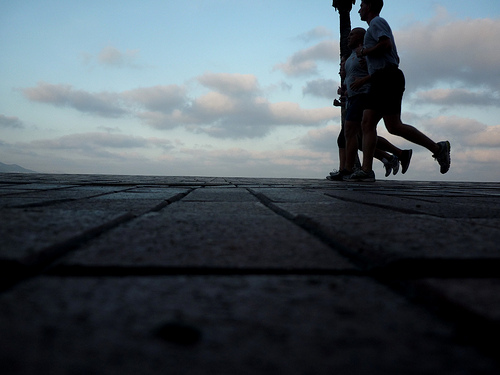By Kenneth Muir (Contributor) – Email
Print Edition: January 25, 2012
It’s time once more to think about vanity. Erm, I mean, fitness. Those two things are in no way related. Do I flex in front of the mirror after I work out? Who told you that? I’ll break his legs. Right after I’m done flexing in front of this mirror.
With your goals and potential exercises in mind, the next step is to actually go do them. This is where most people get hung up. They’ll start to run a few times a week, develop a sore hip after two days, and then never run again. My goal is to not let that happen to you, assumedly avid reader. Let’s talk about what can be done.
What to wear
It’s pretty intuitive: wear what’s most comfortable. It’s not necessary to buy a pair of $400 running shoes if you’re comfortable in those old ones that have been sitting in the back of your closet for the last three years. Function is more important than fancy dress in the realm of fitness. If it feels good (as in doesn’t cause you problems while exercising), then it is good. If it doesn’t feel good, then investing in some new shoes or clothes may not be a bad idea. I highly recommend having spandex shorts and shirts, or anything that reduces friction, if you plan on running or cycling. It’s not a good sign if you walk around like you’re constantly trying to straddle a traffic cone after your workout. Chaffing is serious business. Lastly, if you’re planning to exercise outside, wear slightly fewer layers than you think you’ll need. It’s colder out when standing still than when you’re moving about.
Warming up
Warming up generally refers to throwing your arms and legs about in an effort to get some blood moving through them before you start your workout. It may feel somewhat silly, or even a waste of time, but warming up for five to ten minutes is absolutely crucial to preventing injury, especially if you’re starting to work out for the first time (or starting to work out for the first time in a long time).
Start slowly
Doing things Terry Tate style early on will also lead to early injury, and consequently, a halt in progress. Start slowly. If your goal is to run 30 minutes three times a week, start your first week by jogging and walking for 20 minutes for each session. On the second week, try walking a little less. On the third week, try not walking at all. On the fourth week, try running for 25 minutes. And so on. Small increment steps in progress are the key to success. Trying to run for 30 minutes right away, if you have a low fitness level, is equivalent to riding bareback on a horse for the first time and immediately going “YAW HORSIE,” and sending it at full gallop. It’s going to go wrong (and cause some kind of groin injury).
Expect pain
Despite all efforts to minimize bodily harm at the onset of a new exercise regime, you will still accumulate a monumental amount of soreness in your muscles on your first week. This is completely normal. It’s not a sign that you’re too unfit, or that exercising is too difficult and painful. This initial soreness will last for at most a full week, after which you should never have to feel it again, the clincher being that you need to continue to exercise continuously. Your body simply isn’t accustomed to this kind of stress yet. Eventually it will adapt. It’s important not to get discouraged and to continue your workouts. Yo-yo exercising will result in experiencing this pain again and again, for every consecutive exercise start-up. For those who push through it and keep exercising, you should only feel truly sore again if you do something exceptionally strenuous or exceptionally new, such as changing activities from running to rock-climbing.
With these things in mind, you should be ready to tackle your first few weeks of exercising. Try to stick with it until the next issue, in which we’ll discuss staying motivated.


